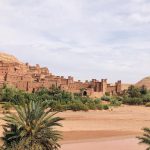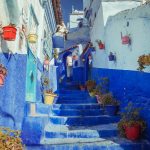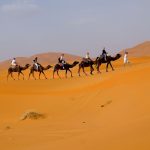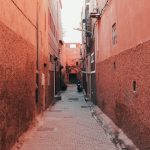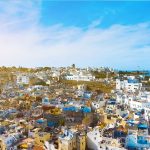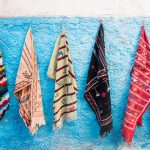The High Atlas may be the most famous mountain range in Morocco thanks to its close proximity to Marrakech and the Oukaïmeden ski station in the Toubkal National Park. The High Atlas sports tricky roads, like the mountain, pass Tizi n’Tichka that leads to the desert.
In the winter, when the weather is clear and cool they are the backdrop of Marrakech. While in the summer they hide behind the haze. A short car ride of thirty minutes brings them into sight. The ride from Marrakech to Imlil is only a little more than an hour. But the slow climb up the mountains is worth the journey itself. Staggering rock cliff faces mixed with sweeping valleys and villages dotting the vistas break up the drive. Unlike many drives up the mountains that are roads of constant switchbacks, the road to Imlil is much smoother – a great asset especially for those who get car sick.
Things to do in the High Atlas Mountains:
Asni: Shimmering in the haze beyond the pink walls of Marrakech, long flecks of snow barely 60km (38 miles) away brush the rugged profile of the southern horizon. This is the Toubkal massif, the craggy mass of rocky peaks and deep valleys that contains the highest summits of the Atlas chain. Roads teeming with people and domestic animals, scooters and lorries belching diesel fumes, cross the hot Haouz plain to Asni, where there is an important Saturday souk, which though mainly a traditional local market for livestock and food, now also sells carpets, the ubiquitous fossils, and other local trinkets. There are a few basic hotels and restaurants in Asni, but most people choose to stay in Imlil. A turning to the right before the market leads up to Moulay Brahim and the Kik Plateau.
Imlil: Imlil has several good cheap places to stay, a scattering of restaurants and lots of souvenir shops, selling carpets, fossils, and jewelry. Thousands flock here in spring and early summer to climb Mount Toubkal and trek in the foothills around. There is also a Bureau des Guides in the village (just opposite the car park), recommended for first-time visitors. Trekking companies are another option and deal with all the logistical problems of organizing porters, provisions, and accommodation.
Trekking at Toubkal Mountain: For a mountain of this height and accessibility to have had its first recorded ascent (by a French party under the Marquis de Segonzac) as late as 1923 testifies to the tribal fortress mentality maintained by local people well into the 20th century. Visitors also go hiking around the district – there are 5–10-day circular tours – the “Toubkal Circuit” – staying overnight in remote huts, Berber outposts and sometimes open-air bivouacs. The mountain can usually be climbed in two days – the first day reaching the CAF Toubkal Refuge (previously called the Neltner Hut) at 3,207 meters (10,522ft), which is about 7 hours from Imlil, and reaching the summit (5 hours) and returning to Imlil (5 hours) on the second day. A lot of people include the ascent as part of longer treks. Note: the ascent can only be made when the snows have melted, between the months of May and October.
Tizi N’test pass: The Tizi n’Test Pass, which reaches a height of 2,092m (6,860ft) above sea level, offers fabulous views of the region, but be warned that the way through the pass entails a lengthy series of hairpin bends. At the summit of the pass, a small restaurant has panoramic views southwards across the Souss Valley, with the ridge of the Anti-Atlas Mountains rising majestically above the haze. On the far side of the pass, the road descends to join Highway N10. From the junction, it is an easy drive to the city of Taroudant.
Tizi N’tichka pass: The Tizi n’Tichka Pass (also known as the N9, linking Marrakech with Ouarzazate) is the highest, most spectacular paved mountain pass in Morocco. Reaching 2,260m (7,400ft), the road snakes through the verdant foothills and pisé villages of the High Atlas, before a series of hairpin bends takes you to the summit of the pass. The landscape then changes, with arid peaks, rocky outcrops and ksour (fortified villages) filling the pre-Saharan landscape.
Kasbah Ait Ben Haddou: Off the Tizi n’Tichka pass, about 20km (13 miles) before Ouarzazate, is a short side road leading to the Kasbah Aït Benhaddou, probably the most celebrated, filmed and photographed kasbah in Morocco. Featured in numerous films (including Lawrence of Arabia, The Sheltering Sky and Gladiator), it is the best-preserved kasbah in Morocco and has 10 families still inhabiting it. Today, many of the residents of this Unesco World Heritage Site are happy to show you around their homes and recount stories of their filming experiences. Access to the kasbah from the road is through the small modern town of shops, restaurants, and auberges that have sprung up to service the stream of visitors. Stepping stones have replaced the mule rides to cross the Mellah River. The kasbah is really a town of many smaller kasbahs, all built from the same deep-red earth and often with intricate details carved into their walls. The huge gate is not part of the original design, but a film fantasy built for Romancing the Stone so that Michael Douglas could drive a plane through it.
Imilchil: Imilchil is a village wreathed in romantic myth and legend and is home to the Aït Hddidou, a tribe of semi-nomadic shepherds originating from Boumalne du Dadès in the 11th century. There is a beautiful kasbah in the village that can be explored, but most visitors come at the time of the Marriage Festival. The best place to stay in Imilchil itself (the festival is held a few kilometers south of the town) is Chez Bassou, which also has a restaurant and mountain guides who can take you into the surrounding Atlas. There are a couple of basic cafés and restaurants in town, too. Gentle river walks run alongside turreted buildings or you can take longer strolls on-piste tracks across kilometers of pasture between the lakes.

